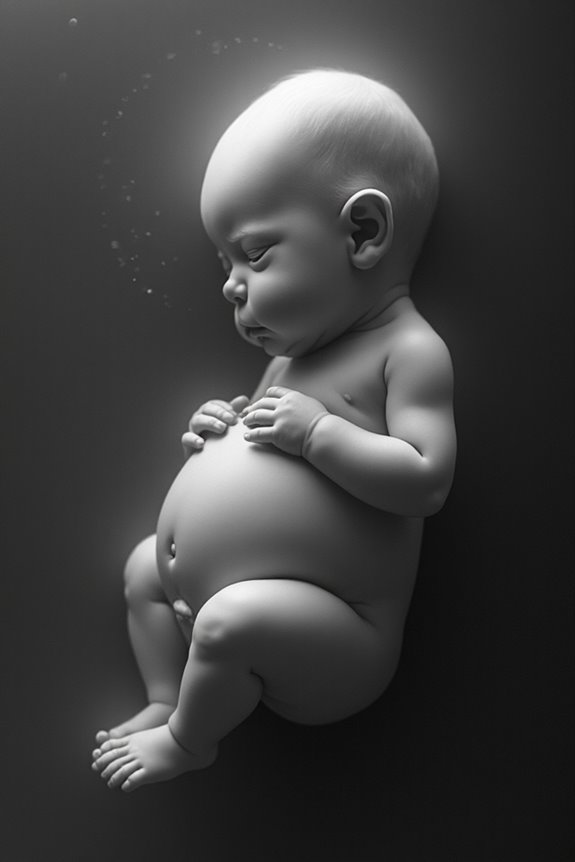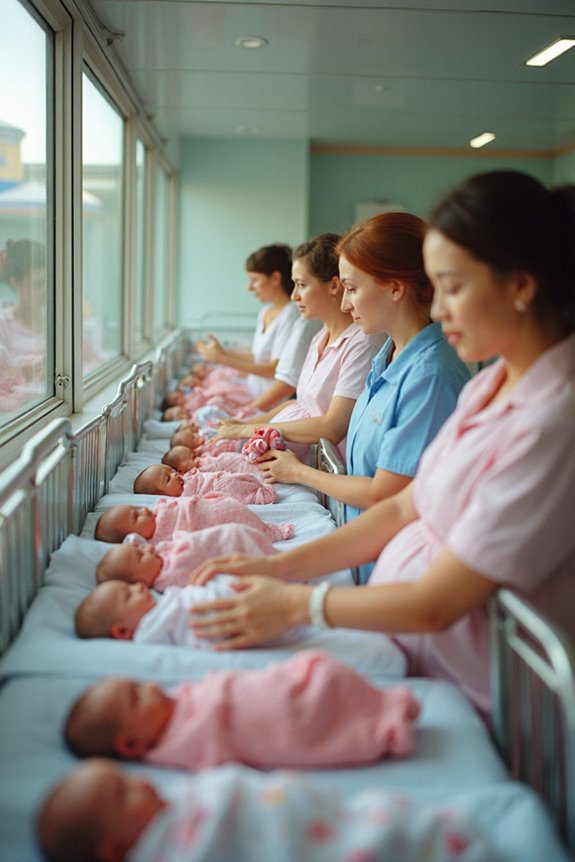Babies come from a remarkable journey that starts with the union of sperm and egg. When sperm meets the egg, fertilization occurs, resulting in a zygote. This zygote develops into an embryo, and later into a fetus over about 40 weeks of pregnancy. The placenta plays a key role, providing nutrients and oxygen while removing waste. Understanding this process helps us appreciate the miracle of birth. There’s so much more to explore about this fascinating topic!
Key Takeaways
- Babies come from the fertilization of an egg by a sperm, forming a zygote that develops into an embryo.
- Pregnancy lasts about 40 weeks and is divided into three trimesters, each with significant developmental milestones.
- A fetus develops major organs and sensory abilities, while the placenta provides essential nutrients and oxygen.
- Monitoring maternal and fetal health is crucial throughout pregnancy to ensure well-being for both.
- The birth process consists of three stages: labor, delivery of the baby, and delivery of the placenta.
Understanding Human Reproduction
Understanding how human reproduction works can feel overwhelming at first, but we’re here to break it down together. Let’s begin with the sperm journey. When sperm are introduced during copulation, they travel through the vagina, cervix, and into the uterus, aiming to meet a viable egg in the fallopian tube. It’s quite a race, with only about 1 in 14 million sperm making it to this crucial spot for fertilization.
Once a sperm meets the egg, they form a zygote, which then begins dividing rapidly on its way to the uterus. If everything goes smoothly, this zygote will develop into a blastocyst before implanting in the uterine wall, marking the beginning of pregnancy. Understanding these steps helps us appreciate the miracle of life.
The Role of Gametes in Fertilization

When we think about fertilization, it’s important to recognize the crucial role that gametes play in creating new life. Each gamete, whether a sperm or an egg, is a haploid cell containing 23 chromosomes. When these gametes fuse, they form a diploid zygote with 46 chromosomes, paving the way for a new organism. This process ensures genetic variation, as each gamete brings its unique genetic material to the mix.
- Male Gametes: Sperm are small and motile, designed to reach the egg.
- Female Gametes: Eggs are larger, providing nourishment for early development.
Through gamete fusion, we witness the beautiful complexity of life beginning, highlighting the wonder of human reproduction.
The Process of Fertilization

Fertilization is a remarkable process that begins with the meeting of sperm and egg, and it’s fascinating to think about how this union sets the stage for new life. Picture the sperm journey: out of 200 million, only about 200 reach the ampulla of the fallopian tube, guided by fertilization hormones like progesterone.
Here’s what happens:
- Capacitation: Sperm prepare for fertilization.
- Penetration: They break through the corona radiata and zona pellucida, using enzymes.
- Fusion: The sperm and egg membranes fuse, allowing their nuclei to combine.
This intricate dance of biology showcases the beauty of conception, reminding us of the delicate balance required for new beginnings. Understanding this process can help us appreciate the miracle of life.
What Happens After Fertilization?

- About 72 hours later, this 16-cell mass, known as the morula, reaches the uterus and prepares for blastocyst formation.
- Within five days, the morula transforms into a blastocyst, featuring an inner cell mass that will become the embryo and a trophoblast layer that forms the placenta.
Next, the implantation process begins, with the blastocyst hatching and attaching to the uterine wall, marking the critical start of embryo development.
The Stages of Pregnancy

As we embark on the journey of understanding the stages of pregnancy, it’s important to recognize that this incredible process typically spans about 40 weeks.
During the first trimester (weeks 1-12), you’ll notice significant changes. Some key trimester milestones include:
- Rapid development of the brain and nervous system.
- The heart starts beating, detectable on ultrasound.
- Morning sickness and food cravings can emerge.
As we move into the second trimester (weeks 13-26), many find relief from early pregnancy symptoms, often feeling more energetic.
In the third trimester (weeks 27-birth), the baby grows rapidly, becoming more active and noticeable.
Understanding these stages and their associated symptoms helps prepare us for the beautiful journey ahead, creating an intimate bond with our growing little one.
Fetal Development Inside the Womb

Understanding fetal development inside the womb is a fascinating journey that reveals how our little ones grow and thrive during pregnancy.
During the early weeks, we witness incredible embryo milestones:
- Weeks 3-8: The neural tube forms, becoming the brain and spinal cord.
- Week 6: Buds for arms and legs appear.
- Week 9: The embryo transitions into a fetus, with all major organs now formed.
As we progress, fetal sensory abilities develop. By weeks 16-18, our baby can hear sounds and its eyes can move, even though they stay closed until week 27. It’s amazing how our little ones start to move, suck their thumbs, and respond to touch, reminding us of their growing presence.
The Importance of the Placenta

After exploring how a baby develops inside the womb, it’s important to highlight the role of the placenta, which is often referred to as the unsung hero of pregnancy. This remarkable organ has several crucial placenta functions:
- Oxygen and Nutrient Supply: It delivers essential nutrients and oxygen from your bloodstream to your baby.
- Waste Removal: The placenta helps remove waste products like carbon dioxide.
- Hormone Production: It produces vital hormones that support pregnancy.
However, placental complications can arise, such as placenta previa or placental abruption, which can affect your baby’s health. Understanding the importance of the placenta empowers us to appreciate this vital connection throughout pregnancy, ensuring both you and your baby thrive together.
Monitoring Pregnancy Health

Monitoring pregnancy health is crucial for ensuring both maternal and fetal well-being, especially since early detection of potential issues can significantly improve outcomes. We can utilize wearable sensors to gain insights into our bodies and our baby’s health in real-time. These sensors track:
- Fetal heart rate and movement
- Maternal heart rate and activities
- Stress levels through heart rate variability
The Birth Process Explained

The birth process is a remarkable journey that brings new life into the world, and understanding its stages can help us navigate this experience with confidence.
- First Stage: This begins with regular contractions, leading to full cervical dilation. We can manage pain effectively through various options, including breathing techniques and support systems.
- Second Stage: Here, we feel the urge to push, culminating in the baby’s birth. Choosing comfortable birth positions can ease this process.
- Third Stage: After the baby arrives, we deliver the placenta, typically within 30 minutes.
Preparing through education classes and creating a birth plan helps us feel more in control. Our chosen labor environment, whether a hospital or birthing center, should support our preferences for a peaceful experience.
Life After Birth and Early Development

As we welcome a new baby into our lives, understanding the immediate care and early development stages can make a significant difference in how we support their growth.
- Newborn Care: Regular assessments and monitoring ensure our little one’s health.
- Early Bonding: Skin-to-skin contact enhances our connection and helps regulate their body temperature.
- Feeding Practices: Breastfeeding provides vital nutrients and aids in weight gain.
- Motor Skills: Initially, their movements are uncoordinated, but they’ll gradually develop neck strength.
- Sensory Development: Newborns respond to touch and begin to recognize familiar sounds and faces.
- Cognitive Milestones: Look for social interactions, like smiling, as they start babbling and tracking objects.
Together, we can nurture their growth and enjoy these precious early moments.
Frequently Asked Questions
How Do Identical Twins Form During Pregnancy?
When we talk about how identical twins form, it begins with an embryo splitting. This fascinating process results in twins sharing the same genetics, creating a unique bond that’s truly special and intimate.
What Are Common Pregnancy Myths Parents Should Be Aware Of?
We’re often misled by pregnancy misconceptions, believing in old wives’ tales about gender prediction and cravings. Let’s embrace knowledge together, supporting each other through this beautiful journey while dispelling these myths that linger around us.
Can Lifestyle Choices Affect Fertility and Conception?
Absolutely, our lifestyle choices play a big role in fertility and conception. By focusing on healthy dietary habits and effective stress management, we can enhance our chances of starting a family together. Let’s prioritize our well-being!
How Does Prenatal Care Support Fetal Health?
Imagine nurturing a garden; just as seeds need sunlight and water, prenatal care—like prenatal vitamins and ultrasound monitoring—supports fetal health, ensuring our little sprouts thrive and flourish in a safe, loving environment.
What Are the Signs of a Healthy Pregnancy?
When we think about signs of a healthy pregnancy, we notice pregnancy symptoms like missed periods and fatigue. These indicators signal fetal development, helping us feel connected to the little life growing inside.





